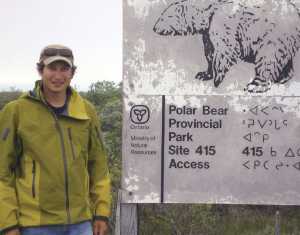
At 32 years old, Trevor Gibb is relatively young to hold the position of Park Superintendent for Quetico Provincial Park, yet he is no stranger to remote and wilderness areas. He got his start in Ontario’s Provincial Park System as a backcountry warden at Killarney Provincial Park in northern Ontario, which is smaller than Quetico but attracts a similar user group, and later became an assistant superintendent in the Cochrane cluster of 29 provincial parks. The latter includes Polar Bear Provincial Park, which is the largest provincial park in Ontario and home to some of the world’s southernmost population of polar bears as well as an internationally important bird area. He also spent two years teaching in an Inuit Community on Baffin Island in the Canadian Arctic.
“I’ve been involved with managing three other wilderness parks in Ontario before coming to Quetico Provincial Park, and each had a different flavor and each provided different experiences that serve me well [managing Quetico],” Gibb said. He started as Superintendent in March of 2014, and has spent that time getting to know the park’s stakeholders and users, and helping to review and shape an updated management plan for Quetico. The goal is to renew a park management plan every 20 years dependent on available resources. Continuing a process that began before he became Superintendent, Gibb hopes to see the renewed plan completed within the next couple years.
“Quetico is a park that’s been around for over 100 years. It was the third park established in the province and it’s a big park, almost 500,000 hectares [more than one million acres] of significant wilderness that is on the border between Ontario and Minnesota. So the management vision is very multi-faceted. It’s a complex park,” Gibb said. Nearly nine years of public consultation have gone into the preliminary management direction. Most recently, emphasis has been placed on making sure that the final document reflects the interests of local Anishinabe communities.
“We’re looking to work as partners with the local First Nations to make shared resource decisions and generally work together where we can. Quetico Park is a big park and it’s been around a long time, but it’s also the traditional lands of the Anishinabe in the area,” Gibb said. Over the last six months in particular, park officials have been working with the Lac la Croix First Nation, which is a First Nation surrounded by park and wilderness: the Boundary Waters Canoe Area Wilderness to the east, Voyageurs National Park to the west. The community has set up a park management advisory committee that has been weighing in on the preliminary park plan for Quetico. Gibb explained that in Quetico (as well as any place that lies within a treaty area), First Nations are allowed to practice treaty rights, which can include traditional activities like fishing, hunting, and harvesting wild rice. They also have the right to use “preferred means” to access the areas where they conduct those activities. That can mean canoeing and hiking, but it can also mean a motorboat or an ATV. And while the latter sometimes concerns wilderness canoeists, Gibb emphasized that First Nations around Quetico value the wilderness area as a wilderness.
“For the most part, the Lac la Croix First Nation who we’ve been working with closely with for many years really deeply value the environment in the park, and any sort of access that’s would impair the visitor experience and that kind of thing would be worked out between the community and the park before hand,” Gibb said.
He also emphasized that while the management plan is not yet final, Quetico visitors shouldn’t expect much to change in terms of their wilderness experience. A lot of management practices will remain the same. “We have managed in a way to preserve the wilderness experience, and that’s one thing we have right,” he said, “That’s not something we’re revisiting.”
That means that visitor regulations will stay roughly the same, though there may be small changes in prices. The overall fee structure and quota system has been designed to do two things: generate funds for park operations and spread out the use of the park. “Occasionally we get questions about how come fees are higher here than in Boundary Waters, and the main difference is that our fees actually pay for the operation of our entire park system and protection. The Ontario Park system is almost self-sustaining, and all user fees are invested in the operation of the entire park system,” he said.
“There are different fees for resident and non-resident backcountry campers and also different fees for different entry stations. Some entry stations along the southern border, like Prairie Portage and Cache Bay are more expensive than Lac la Croix or Beaver House or Atikokan, the reason being it’s a park management tool to distribute the use of the park and minimize impacts on one particular region,” he continued. “Right now, we don’t have a over-use problem and this sort of pricing scheme is one of the tools we use to spread out use. We channel people into different parts of the park along natural travel routes so that we don’t run into situations where certain areas of the park are overused and campsites are being impacted negatively and wilderness aesthetic impacted negatively,” Gibb said.
And that is Gibb’s main message to Quetico stakeholders: Quetico will continue to be maintained as a pristine wilderness. There won’t be signs in the backcountry or designated campsites, and the core experience of backcountry paddling will continue as it has for many decades.
To help follow the management plan process, efforts are made to notify stakeholders and park users at each stage so they can provide park managers with comments. Quetico Park Management documents available for public comment are posted on the Ontario
Environmental Registry at http://www.ebr.gov.on.ca/ for each defined posting/comment period.
By Alissa Johnson
Read more in Wilderness News Spring 2015 >

